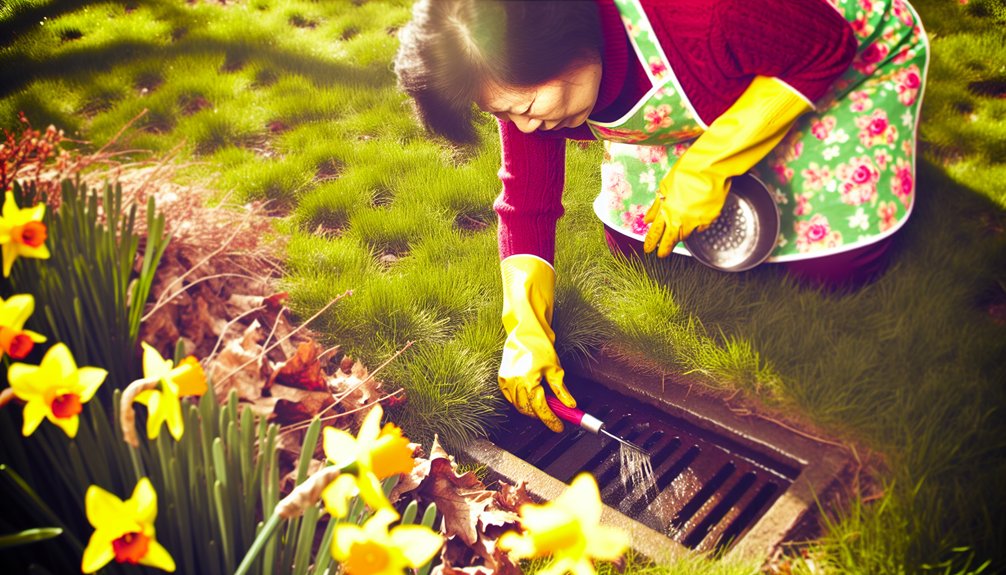Homeowners should prioritize seasonal drain care to maintain efficient drainage. In spring, inspect drains for winter debris and clear hair and soap scum. During summer, monitor water usage and signs of slow drainage, using sink strainers for prevention. Winter preparations include making sure outdoor drains are clear of leaves and snow to avoid ice build-up. Establishing a routine maintenance schedule can help prevent clogs and guarantee smooth operation. Additional strategies for effective drain management await exploration.
Spring Cleaning: Inspecting Drains for Debris Buildup

Spring cleaning presents an opportune moment for homeowners to thoroughly inspect their drains for debris buildup. As winter residue can lead to slow drainage and clogged plumbing, proactive maintenance is essential. Regular removal of hair, soap scum, and food particles from drains can greatly enhance water flow during the bustling spring season.
Homeowners are encouraged to utilize simple tools like a drain snake or a natural mixture of baking soda and vinegar to address minor buildups effectively. It is also prudent to check sink strainers and traps for accumulated debris, ensuring they are cleaned out to reduce the risk of future clogs.
Establishing a routine of drain inspections and maintenance each spring not only fosters a smooth water flow but also helps prevent costly plumbing emergencies later in the year. By embracing these practices, homeowners can enjoy a liberated, hassle-free spring season.
Summer Water Usage: Monitoring for Slow Drainage
How can homeowners effectively manage their water usage during the summer months to prevent slow drainage? Increased water usage can overwhelm plumbing systems, leading to slow drainage in sinks and showers. To combat this, homeowners should adhere to essential drain maintenance tips. Regular inspections for signs of slow drainage, such as water pooling, can help identify potential clogs from debris or grease buildup.
Using sink strainers is a practical way to prevent blockages, capturing food particles and hair before they enter the drainage system. Additionally, monitoring water pressure can reveal plumbing issues; significant drops may indicate clogs or leaks requiring attention. Scheduling routine drain cleaning can also keep plumbing systems clear of accumulated debris, ensuring smooth water flow. By staying vigilant and proactive, homeowners can enjoy their summer activities without the hassles of plumbing problems. Installing a sump pump can further protect against flooding during heavy rainstorms, enhancing overall drainage management.
Winter Preparedness: Ensuring Outdoor Drains Are Clear

As winter approaches, homeowners must prioritize the maintenance of outdoor drains to prevent ice buildup and guarantee proper drainage. A well-functioning drainage system is crucial to avoid issues like clogged drains and subsequent water damage. To start, homeowners should inspect and clean outdoor drains and downspouts, making sure that water flows freely away from the foundation to reduce freezing risks. It is advisable to clear leaves, snow, and debris, which can lead to ice dams if left unchecked. Utilizing a drain snake or high-pressure water can effectively eliminate blockages. Additionally, installing drain covers can prevent larger debris from entering, minimizing the need for frequent cleaning. Regularly checking for signs of ice buildup around drains is essential, as this can impede drainage and increase flooding risks. For those uncertain about their capabilities, a professional inspection can provide peace of mind and guarantee peak performance of the drainage system throughout winter.
Frequently Asked Questions
How Often Should I Clean My Drains With Baking Soda and Vinegar?
When considering drain cleaning with a baking soda and vinegar solution, it is advisable to perform this eco-friendly method at least once a month. This DIY approach aids in clog prevention and odor removal, maintaining ideal drain maintenance. For households with higher usage or pets, bi-weekly cleaning can be beneficial to combat hair and soap scum buildup. Regular use of natural cleaners guarantees a fresh and flowing drainage system throughout the seasons.
What Is the Best Thing to Keep Drains Clear?
When it comes to drain cleaning, homeowners face a formidable battle against the lurking menace of clogs. The best way to keep drains clear involves a combination of eco-friendly solutions and proactive plumbing maintenance. For kitchen sinks and bathroom drains alike, employing DIY methods like baking soda and vinegar can thwart drain odors and prevent plumbing emergencies. Seasonal tips, such as using drain guards and disposing of fats properly, guarantee effective clog prevention.
How Often Should You Snake Your Drains?
The frequency of snaking drains hinges on various factors. Regular drain maintenance suggests homeowners snake their pipes at least once yearly to prevent clogged drains. However, increased usage during busy seasons may necessitate more frequent drain cleaning. Households with pets should consider snaking biannually to combat hair buildup. Plumbing inspections can reveal deeper issues requiring professional services, while DIY methods can serve as effective preventative measures against potential pipe obstructions and drainage solutions.
How Do You Maintain Drain Pipes in a House?
To maintain drain pipes in a house, regular drain pipe maintenance is essential. Clogged drain prevention starts with effective drain cleaning techniques, such as using DIY drain solutions. Homeowners should address common drain issues promptly and utilize eco-friendly drain cleaners for odor removal. Seasonal drain care includes scheduling professional drain services at least once a year, ensuring plumbing system health and preventing costly repairs. Awareness and proactive measures can greatly enhance the longevity of drain systems.



